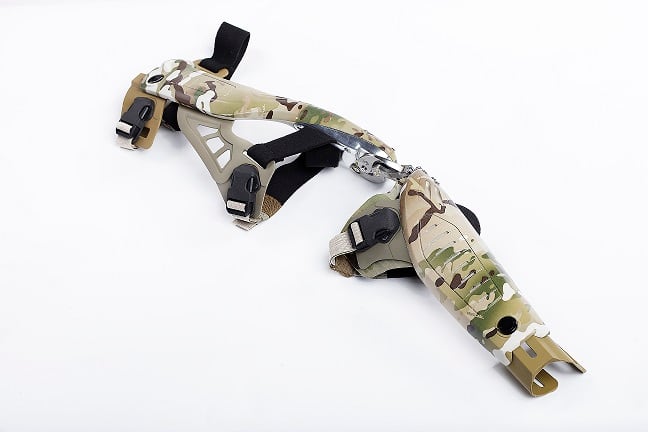The Army is looking for a way to lighten the load of batteries soldiers have to carry around to use their gadgets, and rising to the top of the heap is a tricked-out knee brace that absorbs the energy every time your feet hit the ground.
The PowerWalk, also known as the bionic power knee harvester, looks like a very tactical knee brace, but it's wired to a battery pack that can power radios and other equipment with a weight of less than 7 pounds.
"It's modeled after the HALO video game, which had a brace that was modeled after an old Natick prototype," Noel Soto, a project engineer at the Army Natick Soldier Research, Development and Engineering Center, told Army Times in a Nov. 23 interview.
The team took the futuristic-looking body armor and made it lighter and smaller, Soto said.
Back in 2012, NSRDEC began adapting a medical device designed to help with mobility, turning it into a tactical-looking knee brace that draws power from a soldier's footfalls and feeds it into a wearable battery or the existing power manager, which is hooked up to radios and other equipment.
"When you step down, it adds to the body's breaking motion, and at that point it generates power," Soto said. "The system adjusts to the user almost instantly – two or three steps."
The system works with the Integrated Soldier Power and Data Distribution System, so that the knee brace charges a battery and the battery keeps the hub going.

PowerWalk is one of three leading soldier power-generation systems the Army is working on, next to a chargeable backpack and lightweight, wearable solar panels, out of hundreds of proposals.
"In four years, the technology hasn’t changed. We’re the leading technology that can do this, that provides the most power for the weight," Soto said. "There’s nothing out there that has proven to be better. The state of the art just hasn’t advanced far enough with power generation."
Last July, engineers tested the system for the first time, taking soldier feedback and calculating their movements.
"The soldiers did perceive that there was a limited range of motion, but there really wasn’t," Soto said. "The effort to use them was perceived as very light effort ... Most forgot that they had it on after a few minutes."
The Marines have shown interest in the system and chipped in some money for its development, he added. Right now, a prototype can cost upward of $25,000.
The PowerWalk might also lead to an innovation that the Navy has its eye on, as one of the brace's sensors could help locate someone on the ground in a GPS-denied environment.
"There's a sensor in the knee that detects when to take power," Soto said. "Those same sensors can be used to tell range, azimuth, direction. They could actually use it to create an algorithm to tell where the user is without GPS."
PowerWalk's next step is obstacle course testing. If all goes well, the system could be ready to deploy next summer, Soto said, though it's not yet part of an acquisitions program.
Meghann Myers is the Pentagon bureau chief at Military Times. She covers operations, policy, personnel, leadership and other issues affecting service members.





